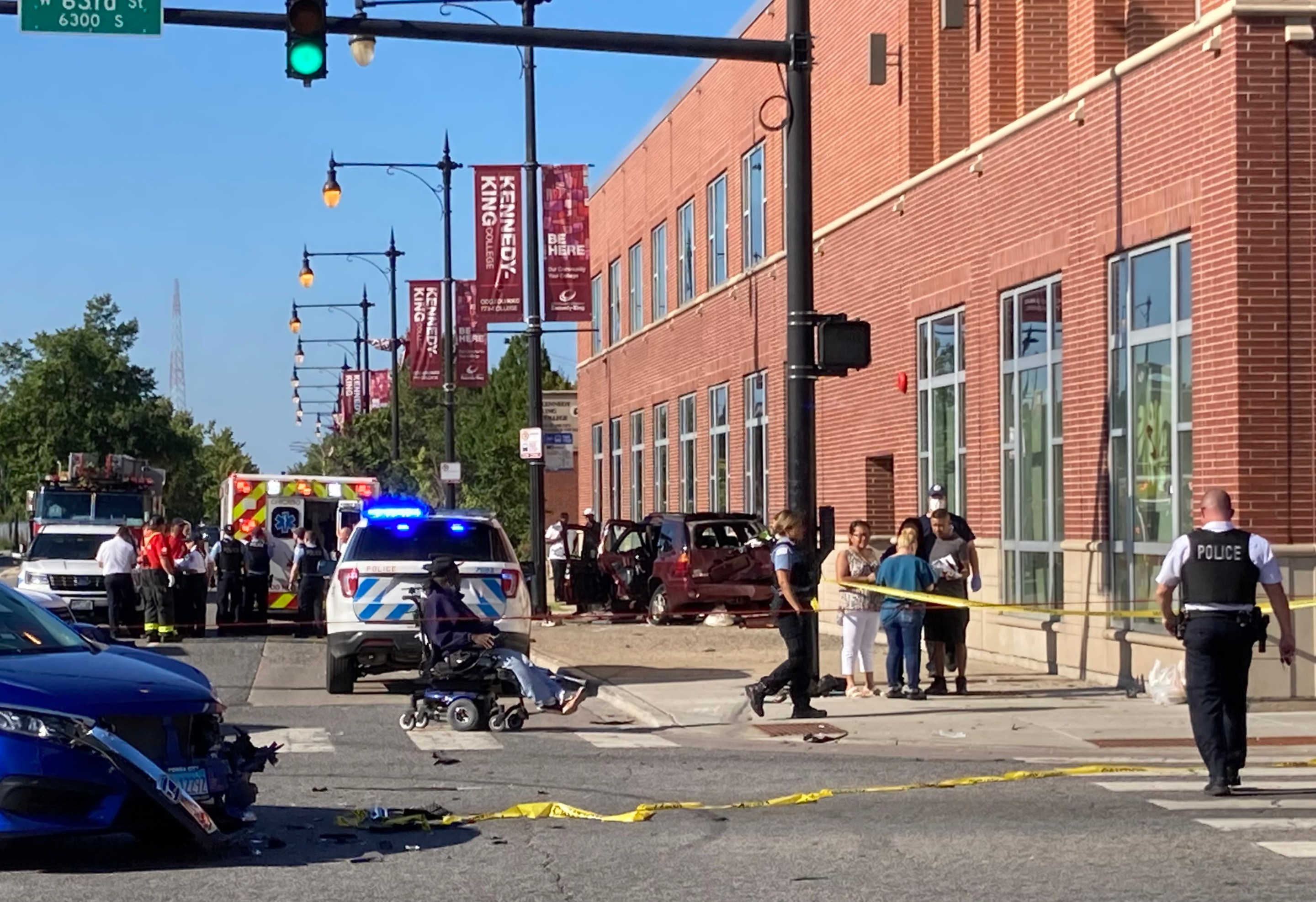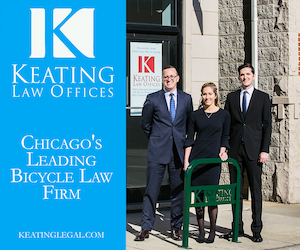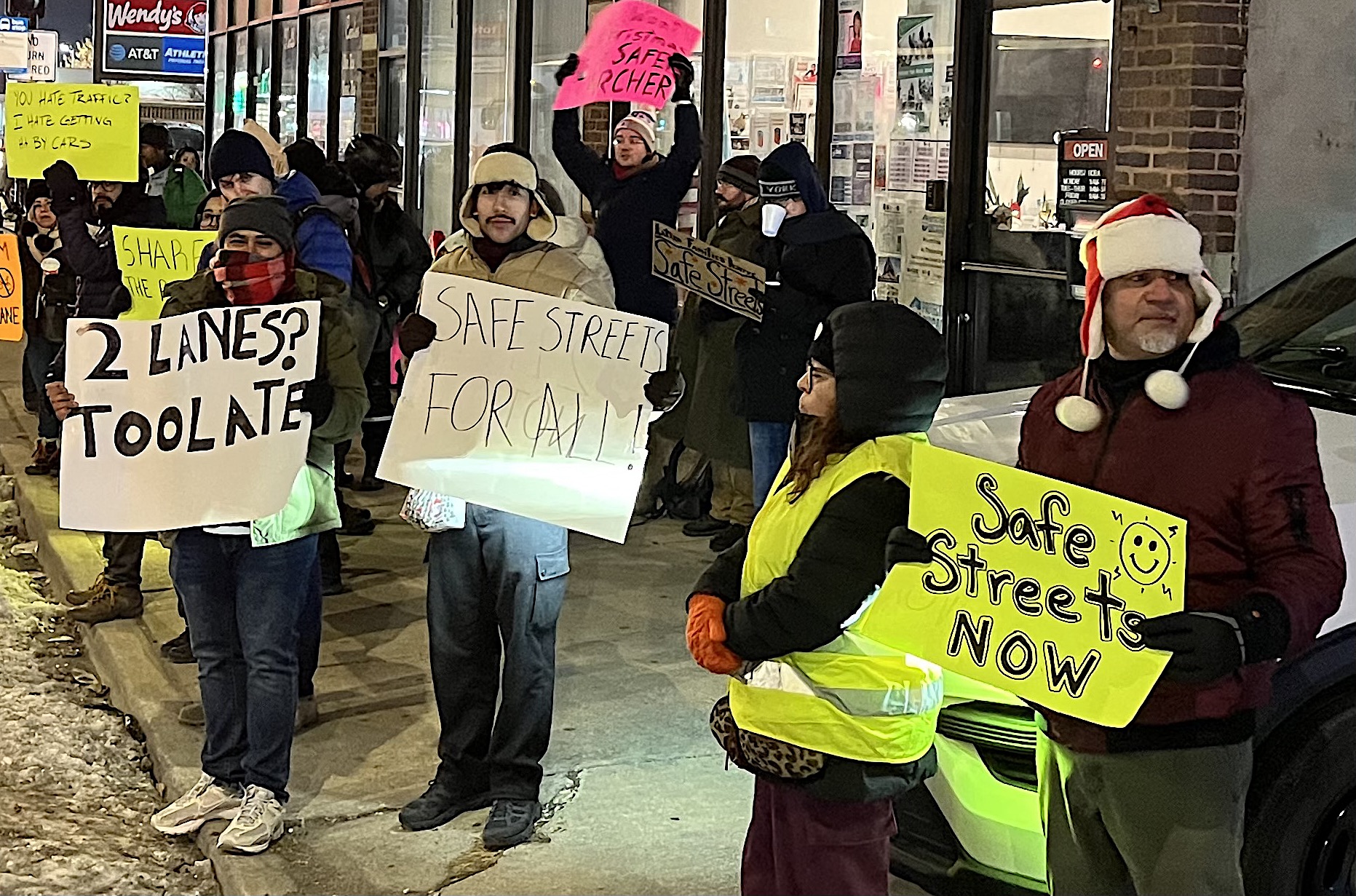There was bad news for safer streets in Chicago today as a proposed ordinance to lower the city's default speed limit from 30 to 25 mph was defeated in the City Council by a vote of 28 to 21. Data from other cities indicates this measure would have greatly reduced the number of serious and fatal traffic crashes.
Alderpersons who voted against the legislation voted equity concerns, some of which were factually inaccurate, and others that don't line align with the experiences of peer cities. They focused on worries that a lower speed limit would cause financial harm to residents of underserved communities, but largely ignored the fact these parts of town are disproportionately impacted by traffic violence.
Last October, after some heated debate, the Chicago City Council's Committee on Pedestrian and Traffic Safety voted eight to five to support the ordinance, sponsored by committee chair Ald. Daniel La Spata (1st). The speed limit for alleys would be 15 mph.
Ald. La Spata was been planning to put the legislation before the full Council for a final vote on January 15, but heard so many questions and concerns from other alders that day that he decided to table the vote. Instead, the Council voted nearly unanimously to create an interagency working group to study the legislation, and its potential costs and enforcement practices. But as it turned out, Ald. La Spata did bring the ordinance up for a vote today.
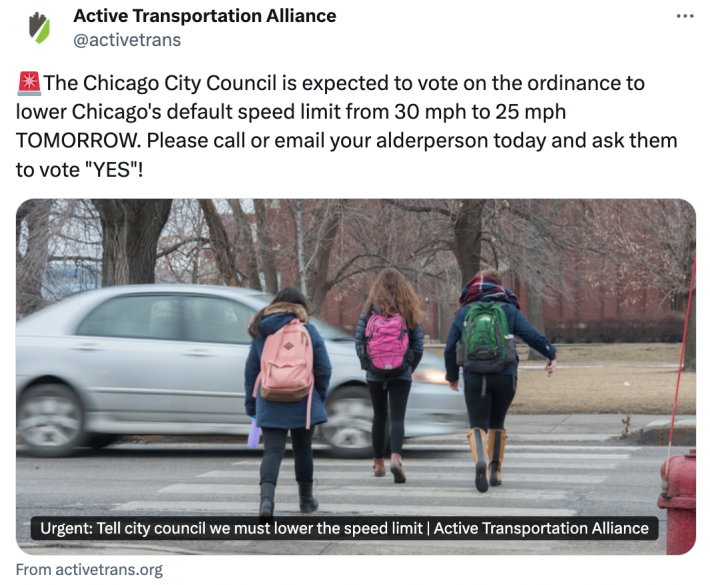
During the public comments section of today's meeting, Active Transportation Alliance Campaign Organizer W. Robert Schultz III discussed some of the arguments for lowering the speed limit. He noted that in 2023, drivers killed 136 people and seriously injured more than 2,000 in the city of Chicago, according to a CDOT study.
He added that other large cities lowered their speed limits years ago and reaped the benefits. After New York City adopted a 25 mph limit, there was a 23 percent drop in annual pedestrian deaths, and the city's fatality rate dropped to its lowest level in a hundred years.
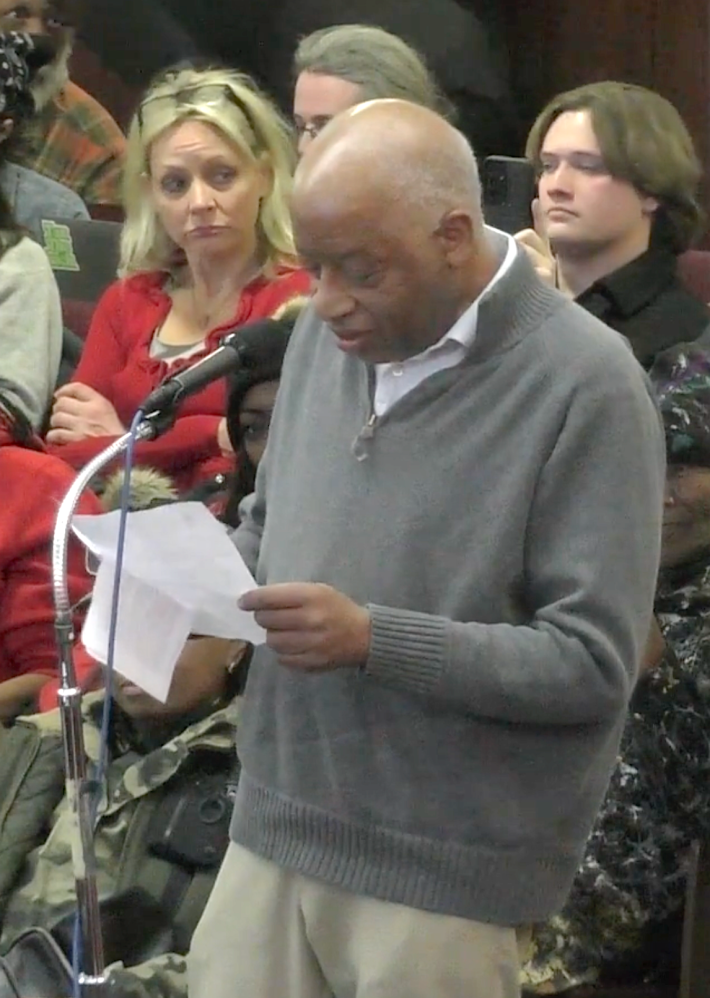
"In Boston, after lowering the speed limit to 25 mph, the city saw a decrease in the most dangerous speeding behavior – over 40 mph – of nearly 30 percent, according to the well-respected Insurance Institute for Highway Safety," Schulz said. He added that the improvements in New York and Boston happened without increased enforcement. (According to Ald. La Spata, lower crash numbers in these cities also occurred without major infrastructure changes, but simply as a result of altering the posted speed limit.)
"Last month, the City Council adopted a resolution to create a working group to reform our city’s approach to traffic fines and fees," Schultz added. "This is an important opportunity to undo harms done by an over-reliance of ticketing and the dangerous practice of pretextual traffic stops. These are issues that can and will be addressed. We can lower the speed limit and create a more just system of accountability at the same time."
in another public comment, Mel Konar, a volunteer with the grassroots advocacy group Better Streets Chicago, also emphasized the proven safety benefits of lowering the speed limit. "Studies show reducing speed limits by just 5 mph, from 30 to 25 mph, can cut the risk of pedestrian deaths in half during collisions," she noted. "With 81 percent of Chicago's streets located within a quarter mile of a school or park, this change would protect our most vulnerable residents.
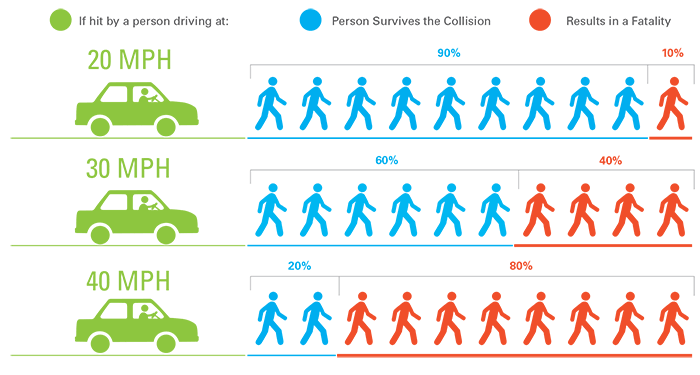
"We already have proof this works in Chicago," Konar added. "When [the Chicago Department of Transportation] reduced the speed limit to 25 mph on North Broadway between Foster and Devon, average speeds dropped by 11 percent and there was a 28 percent reduction in drivers exceeding 30 mph."
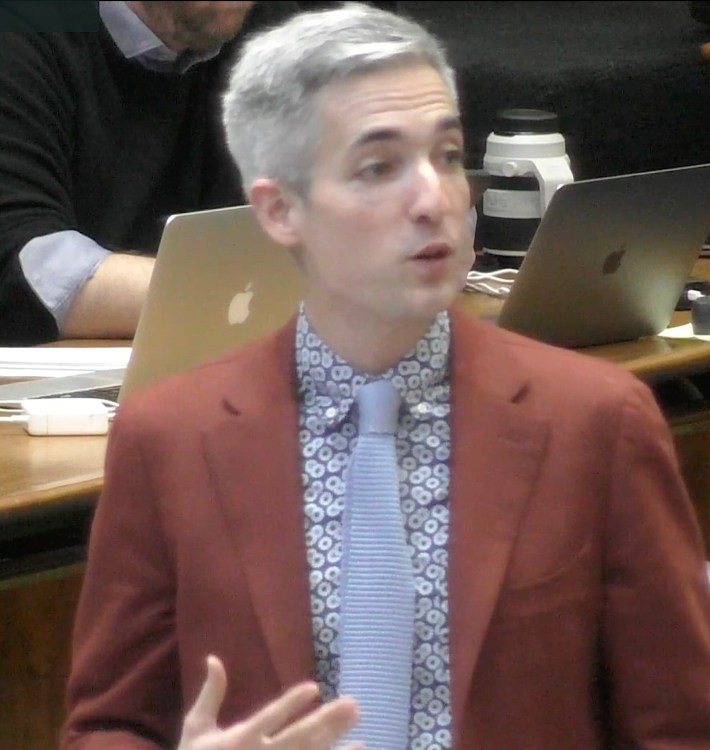
When the measure came up for a vote at the end of the meeting, Ald. La Spata answered the obvious question, after the previous decision to form a working group: Why take the vote now? "We know that some of the most dangerous streets in the city of Chicago are under the jurisdiction of the Illinois Department of Transportation, which controls 10 percent of our roadways, which account for 40 percent of all traffic fatalities," he said. "In conversation with our state legislative partners and conversation with the new secretary of IDOT [former CDOT commissioner Gia Biagi], we know that they stand committed and ready to act with us on lowering the speed limit on those streets as well, but they are not going to act until we act."
"Not only does that make those streets safer, but it has been confirmed by the [Chicago] department of transportation, it also removes the need for the vast majority of signage that would be needed for us to implement that," Ald. La Spata added. "So the $2.6 million cost [for sign installation], that we talked about on various levels, virtually disappears with IDOT's collaboration on this. But if we wait until after their legislative window is closed, we lose that opportunity. So the need for collaboration and coordination at this moment is great."
When it was time for the aldermanic discussion of the ordinance, the most common theme among the opponents was that the speed limit change would hurt lower-income residents and people of color. Several, such as Ald. Ray Lopez (15th), Ald. Jason Ervin (28th), and Ald. Chris Taliaferro (29th) noted that studies have found that a disproportionate number of speeding violations recorded by cameras involved vehicles registered in predominantly African-American and Latino neighborhoods. Some of the alders inaccurately stated that Chicago's speed cams are concentrated in communities of color on the South and West sides.
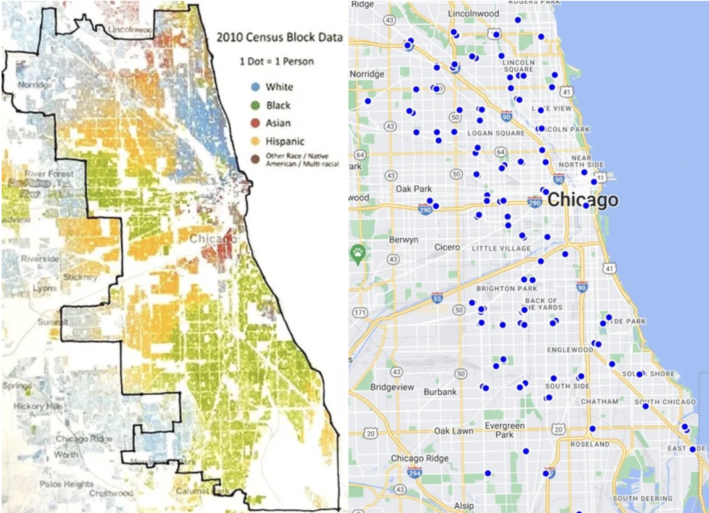
Ald. Lopez argued that it was hypocritical of alders who were in favor of ending Chicago's ShotSpotter gunfire detection contract, intended to prevent gun violence, to support lowering the speed limit to prevent traffic violence. "Pick the lane you want to drive in, whether its your bike or your car."
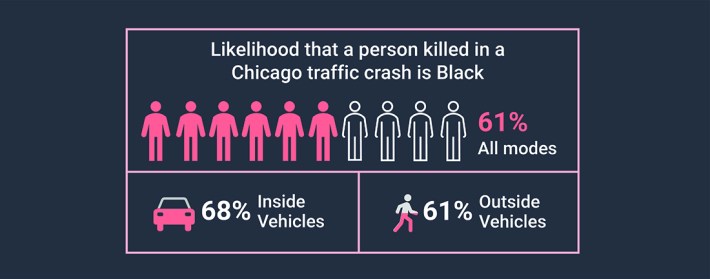
However, Ald. Andre Vasquez (40th) did a good job of nailing down just what was at stake. "I appreciate our colleagues bringing up equity as a concern," he said. "It's a very real concern."
"What we don't talk about when we talk about equity is who's also disproportionately impacted by traffic crashes and [drivers] hitting people," Ald. Vasquez added. "Two to three times more are Black people and people of color. We want to talk about the impact financially. Medical bills sure don't help some people survive and pay their bills, but we don't think about those things."
Sadly, a majority of alders made the wrong decision. Here's how most of them voted.
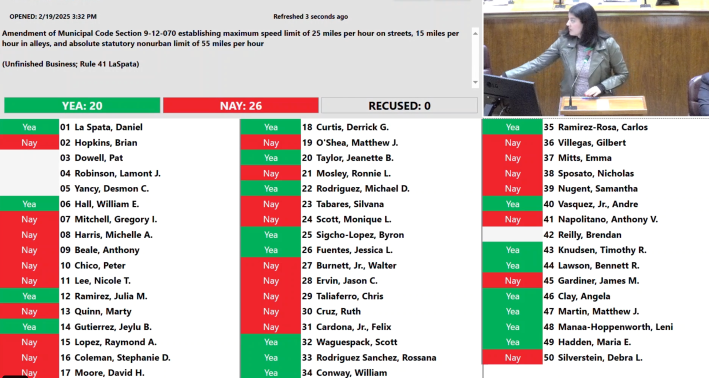
We've reached out to Ald. La Spata's office for a statement on the vote, and what his next steps on this issue might be. We'll update this post if we hear from them.
Update 2/20/25, 8 AM: Block Club Chicago reported that after the vote, Ald. La Spata said he had "zero regrets" about calling the vote. He indicated that, based on previous discussions with alders who wound up voting against the ordinance, he had expected it to pass. "It is different from the way they voiced those concerns to me," he told the news outlet. "I’m disappointed in how the vote went." But he promised that is goal of getting a safer speed limit passed in Chicago "will never be off the table as long as I’m doing this job." Read the Block Club article by Madison Savedra and Mack Liederman here.
Here's a statement on the vote from from Active Transportation Alliance spokesperson Ted Villaire. "We are deeply disappointed by the Chicago City Council's failure to pass the ordinance reducing the citywide speed limit from 30 mph to 25 mph," he said. "This decision represents a missed opportunity to improve street safety for all Chicago residents. Lowering speed limits is a proven method to reduce traffic fatalities and injuries. Cities like New York, Boston, and Seattle have already implemented similar speed limit reductions with positive results. In 2023 alone, there were over 9,000 crashes related to speeding in Chicago, totaling at least $1.1 billion in societal costs, according to the USDOT Benefit Cost Guidance analysis."
So this misguided vote doesn't just mean that more Chicago lives will be sacrificed to allow motorists to drive at unsafe speeds. It also means more of our cash-strapped city's money will be wasted on crash-related costs. Let's hope that if the 25 mph speed limit ever comes before the City Council again, more of our elected officials will do the right thing.

Did you appreciate this post? Streetsblog Chicago is currently fundraising to help cover our 2025-26 budget. If you appreciate our reporting and advocacy on local sustainable transportation issues, please consider making a tax-deductible donation here. Thank you.
